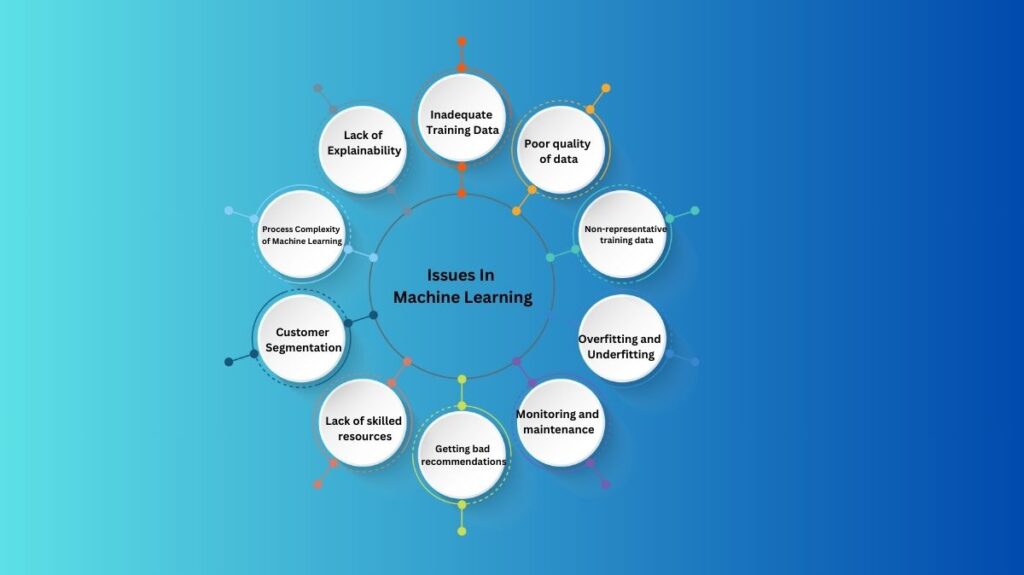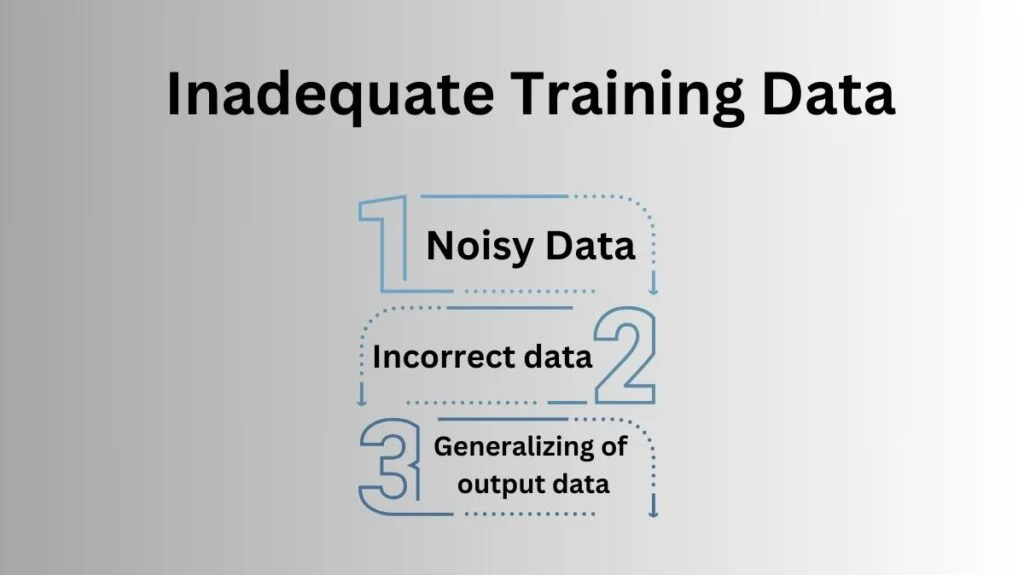Among all data scientists and machine learning enthusiasts, “Machine Learning” is one of the most widely used technologies. It is the best artificial intelligence technique for developing automatic learning systems that can make decisions in the future without regular programming. It can be regarded as an algorithm that uses training data and prior knowledge to automatically create different computer programs.It has an impact on every industry, including healthcare, education, banking, marketing, shipping, infrastructure, automation, and automobiles.
To expand, nearly all significant firms, including Amazon, Facebook, Google, Adobe, and others, employ a range of machine learning tactics. But there are positive and negative aspects to everything in this world. Similar to this, machine learning has many potential applications, but there are still some Issues in Machine Learning that need to be resolved.
What is Machine Learning?
Machine learning is the study of computer algorithms that use training data and prior knowledge to automatically create software.
It is a field of computer science and artificial intelligence that aids in creating models using training data and enables them to make judgments and predictions without continual programming. Applications for machine learning include computer vision, speech recognition, email filtering, self-driving cars, Amazon purchase recommendations, and more.
Commonly used Algorithms in Machine Learning
Machine learning is the study of programs that learn from their mistakes and use that knowledge to make better judgments later on. There are numerous models used in machine learning, however the ones listed below are the most commonly used by data scientists and other workers worldwide.
- Linear Regression
- Logistic Regression
- Decision Tree
- Bayes Theorem and Naïve Bayes Classification
- Support Vector Machine (SVM) Algorithm
- K-Nearest Neighbor (KNN) Algorithm
- K-Means
- Gradient Boosting algorithms
- Dimensionality Reduction Algorithms
- Random Forest
Common issues in Machine Learning
Despite being applied across all industries and assisting organizations in making data-driven, better-informed decisions than traditional approaches, machine learning still has a number of issues that cannot be disregarded. These are some issues in machine learning that experts encounter while trying to teach ML techniques and build an application from scratch.

Inadequate Training Data
The main problem with machine learning algorithms is that there is not enough data, both in terms of quantity and quality. While the processing of machine learning algorithms depends heavily on data, many data scientists assert that noisy, dirty, and insufficient data are severely taxing the algorithms. For instance, a basic activity needs thousands of sample data, whereas a more complex task like picture or speech recognition requires millions of sample data examples. Additionally, the algorithms’ optimal performance depends on the quality of the data, yet machine learning applications can also suffer from poor data quality. The following are some elements that can impact data quality:

Noisy Data-It is in charge of making incorrect predictions that impact both categorization task accuracy and decision-making.
Incorrect data- It is also responsible for incorrect programming and results in machine learning models. As a result, inaccurate data might also have an impact on the accuracy of outcomes.
Generalizing of output data-Generalizing output data can potentially become difficult, resulting in comparatively poor future actions.
Poor quality of data
As previously said, data is quite important in machine learning, and it must also be of high quality. Noisy, incomplete, inaccurate, and dirty data result in lower classification accuracy and lower quality results. As a result, data quality can be viewed as a major common issue while processing machine learning algorithms.
Non-representative training data
To determine if our training model is well-generalized or not, we must guarantee that the sample training data is typical of the new examples that we need to generalize. The training data must include both previously occurred and currently occurring cases.
Furthermore, if we use non-representative training data in the model, the predictions are less reliable. A machine learning model is deemed to be perfect if it can predict well in generalized circumstances and make reliable decisions. If there is insufficient training data, the model will suffer from sampling noise known as the non-representative training set. It will not be correct in its predictions. To address this, it will be prejudiced toward one class or group.
As a result, we should use representative data in training to avoid bias and create precise predictions with no drift.
Overfitting and Underfitting
Overfitting:
Overfitting is one of the most typical issues encountered by machine learning engineers and data scientists. When a machine learning model is trained on a large amount of data, noise and mistakes are introduced into the training dataset. It decreases the model’s performance. Let’s start with a basic example: we have a large number of training data sets, including 1000 mangoes, 1000 apples, 1000 bananas, and 5000 papaya. Then, due to the large amount of biased data in the training data set, there is a considerable possibility of misidentifying an apple as a papaya, leading in a negative prediction.
The main source of overfitting is the use of non-linear techniques in machine learning algorithms, which result in unrealistic data models. We can avoid overfitting in machine learning models by using linear and parametric approaches.
Methods to reduce overfitting:
- Increase the training data in a dataset.
- Reduce model complexity by choosing a model with fewer parameters.
- Ridge and Lasso Regularization
- Early stop during the training phase
- Reduce the noise.
- Reduce the amount of attributes in the training dataset.
- Limiting the model.
Underfitting:
Underfitting is exactly the opposite of overfitting. When a machine learning model is trained with insufficient data, it produces partial and erroneous results, destroying the model’s accuracy.Underfitting occurs when our model is too simplistic to understand the fundamental structure of the data, similar to an undersized pant. This typically occurs when we have limited data in the data set and attempt to develop a linear model from non-linear data. In such cases, the model’s complexity degrades, and the machine learning model’s rules become too simple to apply to this data set, causing the model to make incorrect predictions.
Methods to reduce Underfitting:
- Increase model complexity.
- Remove noise from data.
- Trained for greater and improved features.
- Reduce the limitations.
- Increase the number of epochs to improve the findings.
Monitoring and maintenance
As we know, generic output data is required for any machine learning model; thus, regular monitoring and maintenance become necessary. Different outcomes for different activities necessitate data changes; hence, code editing and monitoring resources become necessary.
Getting bad recommendations
A particular context in which a machine learning model operates leads to poor recommendations and idea drift. Let’s look at an example where a customer was shopping for gadgets at a certain point in time, but their needs changed over time, and the machine learning model continued to tell them the same things even though their expectations had changed. We term this occurrence a Data Drift. Generally speaking, it happens when new data is introduced or when data interpretation shifts. But by consistently updating and tracking data in accordance with expectations, we can get over this.
Lack of skilled resources
Even though the markets for artificial intelligence and machine learning are expanding steadily, these fields are still relatively new. Another problem is the lack of skilled labor, or specialized resources. Therefore, in order to generate and manage scientific materials for machine learning, we require personnel with in-depth understanding of science, mathematics, and technologies.
Customer Segmentation
Customer segmentation is also a critical consideration when creating a machine learning system. To identify clients who paid for the model’s recommendations but did not even check them. As a result, an algorithm is required to recognize consumer behavior and generate an appropriate recommendation for the user based on prior experience.
Process Complexity of Machine Learning
Another big issue for engineers and data scientists who work with machine learning is that the process is very hard to understand. In the same way, AI and Machine Learning are still very new technologies that are being tried and is always changing. Since there are more hits and test runs, the chance of making a mistake is higher than predicted. The method is more difficult and takes more time because it includes things like data analysis, data training, data bias removal, complex mathematical calculations, and so on.
Lack of Explainability
This basically means that the outputs are difficult to understand because they are programmed to produce under specified conditions. As a result, machine learning algorithms suffer from a lack of explainability, reducing their credibility.
Conclusion:
A machine learning system does not operate well if the training set is too small or if the data is not generic, noisy, or polluted with irrelevant features. We discussed some of the primary obstacles that novices experience when practicing machine learning. Machine learning is poised to revolutionize technology. It is one of the most rapidly increasing technologies, with applications ranging from medical diagnosis to speech recognition, robotic training, product recommendations, video monitoring, and beyond.
This ever-changing domain provides enormous job satisfaction, excellent chances, global exposure, and a high compensation. It is a high-risk, high-return technique. Before you begin your machine learning journey, carefully consider the issues listed above. To master this great technology, you must prepare wisely, be patient, and optimize your efforts. Once you win this war, you will be able to overcome the future of work and land your dream job!
